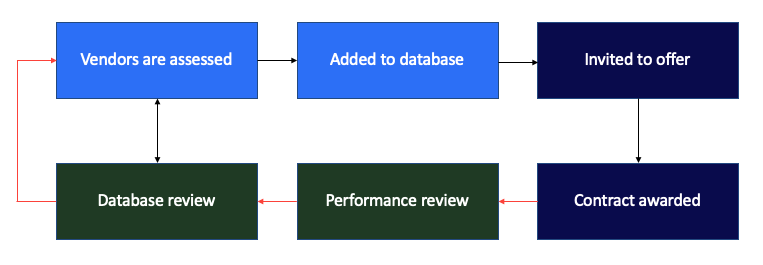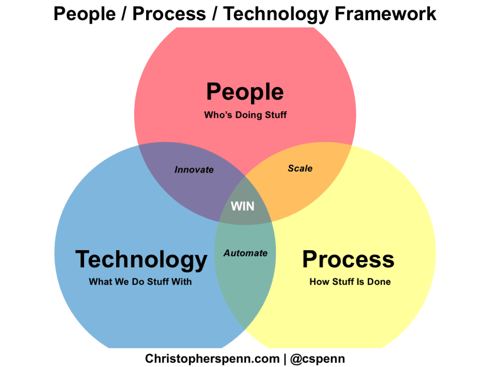Knowing your third-party suppliers and contractors is no longer a nice-to-have. It’s a prerequisite for supply chain risk management. With supply chains becoming increasingly complex and volatile post-COVID, organisations should re-examine the very processes that underpin how they deliver goods/services.
Let's go back to the basics of supplier prequalification with a view to optimise this core piece of the vendor management puzzle.
Contents:
- What is prequalification?
- When should we use prequalification?
- When not to use prequalification?
- Where does prequalification fit in the procurement cycle?
- Is prequalification different from multi-staged procurement?
- Pros of Prequalification
- Cons of Prequalification
- Should we outsource the Prequalification process?
- How to develop Prequalification questions and criteria?
- How to supercharge your prequalification system?
What is prequalification?
Prequalification is a term used in procurement and supply chain management. It is a process to pre-screen competing suppliers against a pre-determined set of criteria. This ensures the vendors have the baseline capacity and capability to provide goods and/or services prior to being invited to bid for a particular project/request.
Vendors that successfully meet the prequalification criteria are generally kept on a database maintained by the buying organisation.
A prequalified status doesn’t guarantee contract win, as the buyer still needs to evaluate offers submitted by prequalified vendors when the need arises. 
Having a good prequalification system can shorten the procurement process and reduces the cost of tendering for both the client and the supplier. It also helps minimise the risk of contract failure as substandard or non-compliant vendors would already have been barred from entry.
When should we use prequalification?
Prequalification is mainly used when procuring a particular type of good/service on a regular basis and the work tends to be large/complex/high-risk, e.g. construction projects, maintenance services, industrial plant works or information technology systems.
Other instances where the use of prequalification is appropriate include:
- The costs of preparing/evaluating bids are high
- A large pool of competing suppliers exists
In summary, the factors to consider when adopting a prequalification strategy are:
- The nature of procured goods/services
- Market factors
- Risk factors
- Procurement costs
- Purchase frequency
When not to use prequalification?
The costs to run prequalification could easily outweigh the benefits in the following procurement scenarios:
- Off-the-shelf goods/services with an abundance of choice
- Low risk categories
- One-off or infrequent purchases
Where does prequalification fit in the procurement cycle?
It can vary depending on the nature of the work required and each organisation’s risk appetite. Normally, prequalification takes place after the organisation has identified a need for a product/service and developed the most suitable procurement strategy.
Prequalification can then be a distinct phase or a requirement to supply equivalent information within the main RFx document set.

There is also a concept of open and closed prequalification registers. An open register allows new vendors to apply for prequalification at any time (e.g. via a publicly accessible link or an invitation email from the organisation).
A closed prequalification arrangement means once a pool of prequalified vendors has been established, no extra vendors can be added until contract expiry. More common within government buyers, a closed prequalification register is more suitable when:
- There is a need for specialist skills within a specific market
- A stable pool of vendors is needed to better enable innovation and risk sharing
Spending too much time building your vendor prequalification questionnaire? Lean on the industry’s standard with Felix Vendor Optiqual®. Learn more here.
Is prequalification different from multi-staged procurement?
Yes, multi-staged procurement is different from prequalification, although they do share some similarities around the aim of cost reduction and early vetting. The main differences are:
- There is often no specific tender in mind for prequalification
- With prequalification, a number of prequalified vendors can win many tenders over time vs. only one vendor that will win the tender in multi-staged procurement
A multi-staged procurement process is useful in complex, high value, new areas or unique goods/services procurement. The table below lists the typical stages involved. 
Source: Thought Bubble
Pros of Prequalification
Prequalification provides several benefits for prospective suppliers and buyers:
- Vendors avoid the expense of tendering if not sufficiently qualified
- Organisations save time by not having to evaluate tender submissions from unqualified bidders
- Raise the awareness of minimum requirements, potentially helping raise the overall quality of suppliers in the market
- Organisations can alter the sourcing strategy in response to the level of interest from qualified vendors
In addition, prequalification enables identification of vendors who are Indigenous-owned, social enterprises, local businesses etc., which helps with meeting social or sustainable procurement targets.
Cons of Prequalification
Some disadvantages of prequalification include the possibility of increased total procurement cost.
Thinking about the golden triangle “People - Process – Technology” and the repetitive nature of the information collected, a manual prequalification process might do more harm than good. That's not to mention the variation in format and questionnaire across different organisations. All of these can drain considerable resources on both sides.
In other words, without a proper prequalification system that incorporates or harmonises the 3 factors above, doing prequalification for the sake of it might result in:
- Potentially outdated vendor data if not periodically updated, or the process of doing so inefficient
- Field staff bypassing the bureaucracy and engaging directly with vendors without a prequalified status
- Process bottlenecks if multiple rounds of stakeholder approval are needed
Should we outsource the Prequalification process?
As with any third-party provider, due diligence should always be exercised. So your organisation needs to effectively “vet the vetter”.
The answer to this also depends on factors such as:
- The number of vendors you want to have
- Your organisation’s risk appetite
- The nature of the goods/services required from vendors
- Your organisation’s internal resources
However, for high-risk supply chains such as construction, mining, and utilities, it’s common for organisations to manage the prequalification process in-house to better enforce governance and ensure data security.
How to develop Prequalification questions and criteria?
Fundamentally, there are two approaches to creating a Prequalification framework that best fits your business.
The first approach is building from scratch, which requires creating fully custom questions that are based on your business needs.
The good thing about this approach is that you can come up with a framework that will match the unique needs of your business. On the other hand, building from scratch can be time consuming and inefficient, due to multiple rounds of feedback with various stakeholders. And yet, it still might not be comprehensive enough.
The second approach is to adopt a standard prequalification framework based on industry best practices (e.g. PAS 91). Example prequalification criteria are shown below:
Standardised frameworks provide assurance of effectiveness, while being more efficient to use as well as easy to implement. The only drawback is that it might not address some specific unique needs of your business, but that can easily be negated by adding custom questions.
How to supercharge your prequalification system?
The real power is when the standardised prequalification questionnaires are combined with smart technology, enabling process governance, efficiency and data accuracy at all times.
Introducing Felix Vendor Optiqual® - a prequalification toolkit built on industry standards.

Recent Articles
2025 in review: Milestones, insights and achievements
2025 – a year of that brought meaningful developments for Felix as we continue to address the evolving needs of organisations navigating complex supply-chain environments.
Top 10 reasons for a centralised vendor database
As organisations grow, so does the complexity of managing vendor relationships. Many still rely on spreadsheets or siloed systems, which can lead to inefficiencies, data inconsistencies, and compliance risks. A centralised vendor database offers a smarter, more scalable solution that brings structure, visibility, and control to procurement operations.
Here are the top 10 reasons why centralising your vendor data is a strategic move.
Five ways poor contract storage could be costing your organisation money
Contracts are the backbone of every business relationship – legally binding documents that define expectations, responsibilities, and value.
But what if the way your organisation stores those contracts is quietly costing you money?
Let's stay in touch
Get the monthly dose of supply chain, procurement and technology insights with the Felix newsletter.








